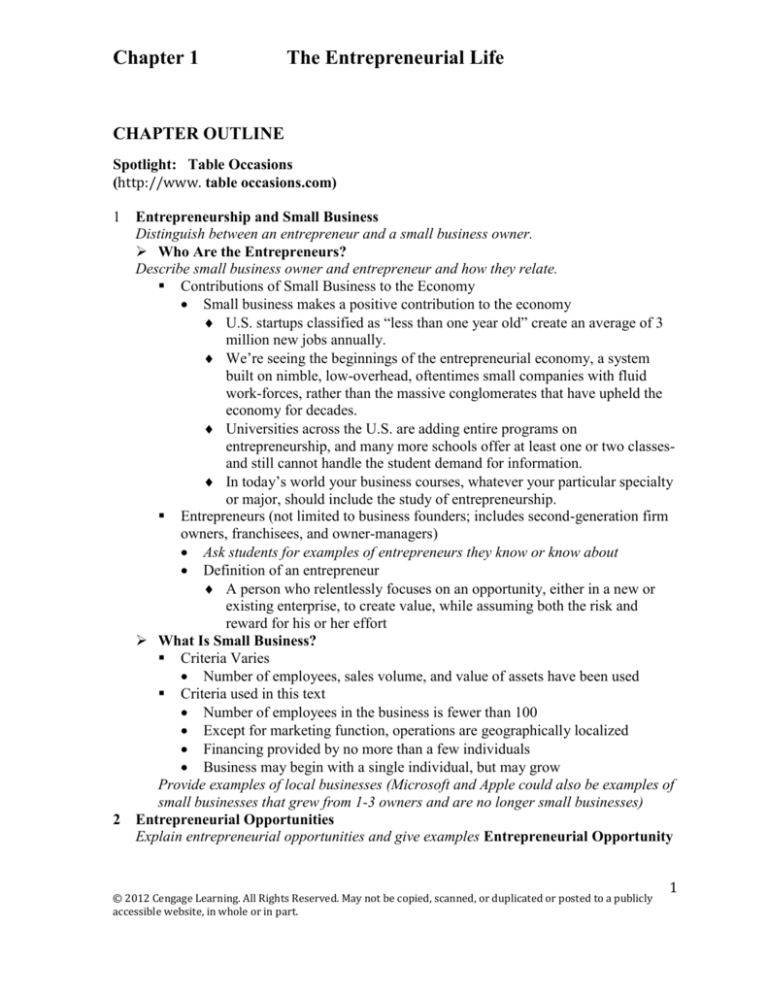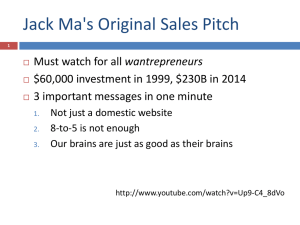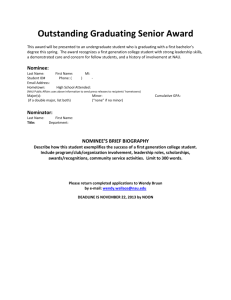
Chapter 1
The Entrepreneurial Life
CHAPTER OUTLINE
Spotlight: Table Occasions
(http://www. table occasions.com)
1 Entrepreneurship and Small Business
Distinguish between an entrepreneur and a small business owner.
Who Are the Entrepreneurs?
Describe small business owner and entrepreneur and how they relate.
Contributions of Small Business to the Economy
Small business makes a positive contribution to the economy
U.S. startups classified as “less than one year old” create an average of 3
million new jobs annually.
We’re seeing the beginnings of the entrepreneurial economy, a system
built on nimble, low-overhead, oftentimes small companies with fluid
work-forces, rather than the massive conglomerates that have upheld the
economy for decades.
Universities across the U.S. are adding entire programs on
entrepreneurship, and many more schools offer at least one or two classesand still cannot handle the student demand for information.
In today’s world your business courses, whatever your particular specialty
or major, should include the study of entrepreneurship.
Entrepreneurs (not limited to business founders; includes second-generation firm
owners, franchisees, and owner-managers)
Ask students for examples of entrepreneurs they know or know about
Definition of an entrepreneur
A person who relentlessly focuses on an opportunity, either in a new or
existing enterprise, to create value, while assuming both the risk and
reward for his or her effort
What Is Small Business?
Criteria Varies
Number of employees, sales volume, and value of assets have been used
Criteria used in this text
Number of employees in the business is fewer than 100
Except for marketing function, operations are geographically localized
Financing provided by no more than a few individuals
Business may begin with a single individual, but may grow
Provide examples of local businesses (Microsoft and Apple could also be examples of
small businesses that grew from 1-3 owners and are no longer small businesses)
2 Entrepreneurial Opportunities
Explain entrepreneurial opportunities and give examples Entrepreneurial Opportunity
© 2012 Cengage Learning. All Rights Reserved. May not be copied, scanned, or duplicated or posted to a publicly
accessible website, in whole or in part.
1
Chapter 1
The Entrepreneurial Life
Economically attractive and timely opportunity that creates value for interested
buyers or end users.
Involves more than just a good business idea.
Three Success Stories
Ace Hotels (Seattle, WA)
Alex Calderwood, co-founder
Calderwood didn’t break the bank creating this personality-driver hotel. He
financed it for less than $2 million, through an equal mix of debt and
investments, and personal money.
Calderwood’s philosophy on how to be cooler than the competition is:
Create intimacy
Be inclusive
Follow the Golden Rule
Be original
Calderwood’s keen focus on people, whether it’s targeted at satisfying local
consumers or hand-picking his creative staff is something every small
business owner can learn.
Late Model Restoration Supply (Waco, TX)
Shannon Guderian, owner
At age 26 Guderian saw the need for parts for late model cars so he quit his
job and pursued his dream.
Started with With only $7,000 in his pocket from selling his car, and without
any business experience, he started calling on everyone he knew in the
industry , asking for their advice.
Guderian started with 17 part numbers from one vendor and a $20,000 bank
loan to help finance his small inventory.
Today the business is in a 27,000 square foot building with a showroom where
he displays Mustangs.
Annual net sales have now reached over $17 million.
Examples show people who took advantage of opportunities and became successful
3 So You Want to Be an Entrepreneur
Describe some motivators or rewards for owning your own business.
Enjoy Satisfying Work
Satisfaction experienced from running their own businesses is a reward as well as
independence
Finding Fulfillment
Positive contribution to the community in which they live
Small businesses can actually see the contribution
Develop Financial Wealth
Making a profit important for firm’s survival
Business should compensate owner for his/her investment of personal time,
personal money, and risk he/she is taking
Plan to get rich slowly
Be Your Own Boss
2
© 2012 Cengage Learning. All Rights Reserved. May not be copied, scanned, or duplicated or posted to a publicly
accessible website, in whole or in part.
Chapter 1
The Entrepreneurial Life
Although attractive, expect to work very hard and for long hours
Satisfaction of making your own decisions to build the business
Escape a Bad Situation
Reluctant entrepreneur – a person who becomes an entrepreneur as a result of
some severe hardship
Refugee – a person who becomes an entrepreneur to escape an undesirable
situation
Example: Reeboot Strategy (Austin, TX)
Karyn Couvillion and husband started because both were in bad situations
4 The Many Varieties of Entrepreneurship
Identify some of the basic types of entrepreneurs and entrepreneurial ventures.
Founder Entrepreneurs versus Other Business Owners and Franchisees
Founders are “pure” entrepreneurs who bring new or improved products or
services to market
Franchisees differ due to having less independence
High-Potential Ventures versus Attractive Small Firms and Microbusinesses
High-potential ventures (gazelles)
A small firm that has great prospects for growth
Attractive small firms
Provides substantial profits to its owners, major segment of small businesses
Lifestyle business
A microbusiness that permits the owner to follow a desired pattern of living
Artisan versus Opportunistic Entrepreneurs
Artisan Entrepreneur: Technical job experience, but little business knowledge
often characterized by:
Paternalistic
Reluctant to delegate authority
Few capital sources to create their firms
Define marketing strategy in terms of traditional components (price, quality,
company reputation)
Primarily personal sales efforts
Short time orientation, little planning for future growth or change
Opportunistic entrepreneur: person has both sophisticated managerial skills and
technical knowledge typically characterized by:
Avoiding paternalism
Delegating authority necessary for growth
Employ various marketing strategies and types of sales efforts
Obtain original financing from more than two sources
Plan for future growth
Entrepreneurial Teams
Two or more people who work together as entrepreneurs on one endeavor
Able to use talents, skills and resources of team
5 The Competitive Edge of Entrepreneurs
Describe five competitive advantages of small and large firms.
© 2012 Cengage Learning. All Rights Reserved. May not be copied, scanned, or duplicated or posted to a publicly
accessible website, in whole or in part.
3
Chapter 1
The Entrepreneurial Life
Customer Focus
Small businesses in general are able to provide better customer focus
Quality Performance
Often surpass quality performance of large business
Quality independent of firm size
Integrity and Responsibility
Reputation for honesty and dependability important at a time when stories of
corporate greed and corruption are in the news
Innovation and Globalization
Thomas Friedman (The World Is Flat) indicates that “anything can now be done
from anywhere in the world”
Large businesses tend to emphasize the improvement of existing products
sidetracking creative ideas that don’t meet that criteria
Bhide indicates that small businesses are more capable of taking inventions or
innovations developed elsewhere and putting them into use
Smaller firms have less bureaucracy to deal with than small businesses
Globalization helpful to smaller firm competition
Special Niche
A market segment identified by an identifiable but narrow range of product or
service interests
6 Getting Started
Discuss factors related to starting an entrepreneurial career.
Age and Entrepreneurial Opportunity
Knowledge and experience more important than age
Time to accumulate startup money important factor
Entrepreneurs in the 25 to 35-year age group account for the highest percentage of
new ventures according to research conducted by Paul Reynolds
Generation Y, the Millennials, or twenty-somethings creating a new breed of
entrepreneurs
Age not of concern, success can happen at any age
Characteristics of Successful Entrepreneurs
Timmons and Spinelli research describe “desirable and acquirable attitudes and
behaviors” under six descriptions
Commitment and determination
Leadership
Opportunity obsession
Tolerance of risk, ambiguity, and uncertainty
Creativity, self-reliance, and adaptability
Motivation to excel
Attitudes to avoid
Overestimate what you can do
Lack an understanding of the market
Hire mediocre people
Fail to be a team player
4
© 2012 Cengage Learning. All Rights Reserved. May not be copied, scanned, or duplicated or posted to a publicly
accessible website, in whole or in part.
Chapter 1
The Entrepreneurial Life
Be a domineering manager
Not share ownership in the business in an equitable way
The Importance of Mentors
Mentors
A knowledgeable person who can offer guidance from their experience in a
given field
7 Success in Business and Success in Life
Explain the concept of an entrepreneurial legacy and its challenges. Looking Back at an
Entrepreneurial Life
Upon final exit from the business questions of reflection occur.
An entrepreneurial legacy is established- this becomes everything that one has left
behind.
Winning the Wrong Game
Don’t win the wrong war – excessive focus on money or work can twist the
entrepreneurial process
Crafting a Worthy Legacy
Material assets and intangible qualities passed on to both heirs and society
Beginning with the End in Mind
Establish goals for business
Evaluating Accomplishments- set criteria for assessment of progress
8 Where to From Here
End of Part 1 (Chapter 2) discusses the fundamental values of the entrepreneur
Parts 2 and 3 look at a firms basic strategy, the various types of entrepreneurial
ventures, and initial planning required for startups
Parts 4 – 6 deal with marketing and management of a growing business.
ANSWERS TO END-OF-CHAPTER DISCUSSION QUESTIONS
1. The three stories discussed at the beginning of the chapter are to some extent
exceptions to the rule in the amount of success the entrepreneurs experienced.
What then is their significance in illustrating entrepreneurial opportunity? Are
these stories misleading?
These examples provide dramatic illustrations of the substantial success one might
achieve. Realistically, we recognize that only a few ventures are so spectacularly
successful, that many others experience moderate success, that others are only
marginally successful, and that a few fail. Many entrepreneurs find fulfilling lives
in successful, independent careers without becoming multimillionaires. The
success stories in the text show the great entrepreneurial opportunities available in
this country. They suggest that we may go as far as our desires, abilities,
preparation, and divine providence permit.
© 2012 Cengage Learning. All Rights Reserved. May not be copied, scanned, or duplicated or posted to a publicly
accessible website, in whole or in part.
5
Chapter 1
The Entrepreneurial Life
2. What is meant by the term entrepreneur?
Entrepreneur is a French term that dates back to the early eighteenth century. It
refers to an individual who founds or starts a business firm. (The term also includes
partnerships and entrepreneurial teams.) In this book we extend the definition to
include owner-managers who operate firms started by others. The characteristics of
risk-taking and innovation are associated with the image of the entrepreneur.
3. Consider an entrepreneur you know personally. What was the most significant
reason for his or her following an independent business career? If you don't
already know the reason, discuss it with that person.
Answers will vary, of course. Some students should know some entrepreneurs—
parents, friends, or employers—quite well. The instructor might ask students first
to explain the basis of their relationship with the entrepreneur and then to discuss
their perceptions of that person’s motivations.
4. The motivators/rewards of profit, independence, and personal fulfillment are the
reasons that individuals enter entrepreneurial careers. What problems might be
anticipated if an entrepreneur were to become obsessed with one of these
rewards—for example, if he or she had an excessive desire for profit,
independence, or a particular life-style?
A balanced perspective is needed. While each reward can give a strong motivation
to build a good business, each also has some potential for creating havoc in an
unbalanced life. An excessive desire for profit can lead to attempts to make shortrun gains at the expense of long-run customer or employee relationships. It may
also tempt one to lower ethical standards and to neglect family relationships. An
excessive desire for independence may make one difficult to deal with in
interpersonal relationships. Some degree of perceived interdependence between
employer and employee contributes to mutual respect and cooperative
relationships. An excessive desire for a satisfying way of life may dull one’s
sensitivity to cost and profit issues. An entrepreneur must achieve a profit goal in
order to be able to afford a life-satisfaction goal.
5. Distinguish between an artisan entrepreneur and an opportunistic entrepreneur.
An artisan entrepreneur is a person with technical job experience (e.g., a painter
who becomes a painting contractor) and who lacks general abilities in business
management. An opportunistic entrepreneur has a more general education than the
artisan entrepreneur and thinks in broader terms of strategy and financial planning.
6. What is the advantage of using an entrepreneurial team?
6
© 2012 Cengage Learning. All Rights Reserved. May not be copied, scanned, or duplicated or posted to a publicly
accessible website, in whole or in part.
Chapter 1
The Entrepreneurial Life
Individual entrepreneurs frequently have weak spots in education or experience.
An entrepreneurial team makes it possible to cover such weaknesses by using
individuals with varied talents and backgrounds.
7. Explain how customer focus and innovation can be special strengths of small
businesses.
Small businesses are generally less bound by bureaucracy and corporate policies
and usually maintain closer relationships with their customers. In other words, their
flexibility affords them the ability to focus on their customers and meet their needs,
which naturally generates customer loyalty. At the same time, small firms often
grow out of the innovative ideas of their entrepreneurial founders, and therefore
this mindset is likely to prevail in the small business.
8. Why is the period from the mid-20s to the mid-30s considered to be the best time
in life for becoming an entrepreneur?
Most individuals in this age category have a significant amount of education and
preparatory experience. At the same time, they typically are not locked into salaried
positions by heavy commitments to pension plans, extensive family obligations,
and so on.
9. Explain the concept of an entrepreneurial legacy.
A legacy refers to what one leaves behind or passes on to others – to one’s heirs
and to others. An entrepreneurial legacy refers to the entrepreneurial aspect, the
business side, of one’s legacy, and thus is concerned with what the business
experience has meant to all those affected. This includes the tangible elements such
as financial resources passed on to heirs and others and also the intangible elements
such as the impact of the entrepreneurial experience on family relationships and the
example of entrepreneurial integrity or avarice given to the community.
10. Explain the following statement: "One can climb the ladder to success only to
discover it is leaning against the wrong wall."
Entrepreneurial achievements are varied, and the way we measure them also varies.
If an entrepreneur concentrates too much on achieving financial goals, for example,
that person may fail dismally in other areas of life such as family relationships. The
statement points to the need to have one’s goals properly defined and to have one’s
efforts properly forecasted.
© 2012 Cengage Learning. All Rights Reserved. May not be copied, scanned, or duplicated or posted to a publicly
accessible website, in whole or in part.
7
Chapter 1
The Entrepreneurial Life
COMMENTS ON CHAPTER “YOU MAKE THE CALL” SITUATIONS
Situation 1
1. Should this venture be regarded as entrepreneurial? Is the owner a true
entrepreneur?
Whether this is entrepreneurial depends on one’s definition. The owner may or
may not be a founder—the key issue in some definitions of a “true” entrepreneur.
In this text, we use a looser definition of entrepreneur, which could include this
owner-manager regardless of whether he founded the business. The venture is
apparently not the high-growth, high-potential type. It may well be what we have
called an “attractive small company.”
2. Do you agree with the philosophy expressed here? Is the owner really doing what
is best for his family?
This question calls for opinions and permits some discussion of the conflicting
values and rewards in business. Some may feel the owner is insufficiently
motivated to grow and even to serve his own family properly in that way. Others
will see the family values and careful growth as appropriate. The question permits
the instructor to discern the general orientation of students in a class. How many,
after discussion, will give a vote of commendation to this owner? You might ask
students to guess the owner’s age.
3. What kinds of problems is this owner trying to avoid?
The owner is apparently avoiding or reducing problems related to inadequate
customer service and product/service quality—areas of difficulty in a rapidly
growing business. Also, the personnel and management functions (e.g., delegation,
finding qualified key people) are simplified by slow growth. Slow growth may
either postpone a transition to professional management or permit a more orderly
transition to it.
Situation 2
1. What do you like and not like about the Simple Bills concept?
This is a win-win situation for everyone. The utility companies win because they get
paid in a timely fashion and don’t have to incur the cost of collecting past due utility
bills. The apartment owners win because the utility bills remain in the tenants name
and the owners don’t incur the risk of incurring past due utility bills. The tenants win
because they don’t have to take on the task of collecting payment from their
roommates. The owners of Simple Bills win because they make money by providing
a low-cost, low-overhead service to their customers.
8
© 2012 Cengage Learning. All Rights Reserved. May not be copied, scanned, or duplicated or posted to a publicly
accessible website, in whole or in part.
Chapter 1
The Entrepreneurial Life
2. Would you recommend raising funds from outside investors and growing faster
or continuing to bootstrap the operations to conserve ownership? Why?
While these entrepreneurs may not want to give away ownership of their business for
fear of losing profits, they fail to see the bigger picture. By bringing in investor
capital, they will be able to grow the business into something much bigger. By
growing the business bigger (from say a $1 million company to a $100 million dollar
company), their profits will be bigger. If the owners retain 60% control of the
business, wouldn’t it be better to have 60% of $100 million rather than 100% of $1
million? Indeed, by including investors, the company has the opportunity to grow
into something much larger, and more quickly, rather than by bootstrapping this
operation.
3. What strategy would you suggest for growing the business, assuming new
investors are brought in?
As a high-potential venture, this company may want to seek our angel capital
financing. Depending on how large Simple Bills wants to grow (state-wide versus
nation-wide) will determine the type of financing these owners will pursue. A nationwide growth plan would require venture capital financing while a smaller growth plan
could utilize angle capital.
Situation 3
1. Is Dover’s feeling of unfairness justified? Is his business entitled to some type of
legal protection against moves of this type?
Dover’s feeling is understandable but difficult to defend rationally. The
business has prospered, to some extent at least, by functioning in a free enterprise
system. Capitalism does not protect one from competition. The law, of course,
offers some protection from unscrupulous competition—for example, practices
such as predatory pricing designed to drive competitors out of business.
2. How should Dover plan to compete against Wal-Mart, if and when this becomes
necessary?
Large retailers and discounters are more successful in some fields than in others.
They are very strong, for example, in drugs, lumber, and general merchandise. In
sporting goods, small firms continue to compete very well. Wal-Mart’s forte will
be price competition. Dover must emphasize those factors that give small firms
unusual strength: personal attention, excellent product knowledge, product lines
that exceed those of a discount chain, advertising programs tailored to the interests
of their customers, attractiveness (and possibly renovation) of physical facilities,
and activities that will gain attention in the news media and thereby deny Wal-Mart
a news monopoly. In brief, the store should do everything it does better than its
© 2012 Cengage Learning. All Rights Reserved. May not be copied, scanned, or duplicated or posted to a publicly
accessible website, in whole or in part.
9
Chapter 1
The Entrepreneurial Life
competitor is able to do. If this family business can be an aggressive, bold
competitor, it can continue to survive and do well.
Meg Whittemore (a writer for Nation's Business) describes a small hardware
business threatened by the advent of Wal-Mart in Sterling, Colorado. To cope with
the new competition, the owners of the hardware store dropped product lines in
which Wal-Mart was strongest and concentrated on basic hardware lines—paint,
tools, electrical items, plumbing, carpentry supplies, lawn and garden supplies—
and offering customers advice and instructions on how to use those items. In these
areas, they could do better than Wal-Mart, and their sales tripled after Wal-Mart
moved into town.
SUGGESTED SOLUTION TO CASE 1: NAU
1. What were Nau’s founders’ primary motivations for founding Nau?
Nau founders were committed to using their business as a force for change. They
combined eco-friendly and “mountain-climbing chic with fashion forward urban
cool.” They indicated that their goal was “To demonstrate the highest levels of
citizenship in everything we do: product creation, production, labor practices, the
way we treat each other, environmental practices, and philanthropy.” Chapter 1
calls this “Making Meaning.” This indicates that the entrepreneur is committed to
making the world a better place. The design philosophy is built on three criteria:
beauty, performance, and sustainability.
2. What kind of entrepreneurial venture is Nau?
Nau sells expensive outdoor-type clothing with the added incentive of style and a
donation to charities from each purchase. In their quest to make meaning, the
founders of Nau established a Code of Conduct that dealt with human rights for
the business, sustainable business practices, environmentally friendly clothes, and
social responsibility. The Business DNA includes Nau Rules of Corporate
Responsibility: Section 1: Environmental and Social Responsibility, Section 2:
Management of the Business and Affairs of the Corporation, and Section 3:
Philanthropy.
3. How do you feel about management’s decision to give a percentage of the
firm’s sales to charity? Describe the pros and cons of such decision.
Students should provide their feeling on the charity issue. Information is available
on Nau’s website that discussed the charities chosen by Nau. The philanthropy
espoused by Nau is 2% of each sale to one of the partner organizations (chosen by
the customer at the point-of-sale). The organizations are Ashoka, Ecotrust, Mercy
10
© 2012 Cengage Learning. All Rights Reserved. May not be copied, scanned, or duplicated or posted to a publicly
accessible website, in whole or in part.
Chapter 1
The Entrepreneurial Life
Corps, Breakthrough Institute, and Kiva. (http://www.nau.com/partners-forchange/).
Pros for this decision include the following:
Purchases of the products make the customers feel good about the
purchase because they got a good product and gave to charity
The charity donations relate to the goal advertised by the business
The charities are aided by the funds donated by the business
Cons for this decision include the following:
The cost of the products must be increased to provide the donation to
charity
The customers may not relate well to the charities chosen by the business
Forces customers to give to charity
4. Nau’s owners think of their clothing line as part Patagonia
(http://www.patagonia.com and part Prada (http://www.prada.com). Review
the websites of these two companies. What do you believe Nau’s owners saw
in Patagonia and Prada that was relevant to their idea for a startup?
Patagonia has a large imprint of environmentalism on its website called The
Footprint Chronicles®. These chronicles include the tracking of “the impact of
specific Patagonia products from design through delivery.” The mission statement
is very similar to that of Nau: “Build the best product, cause no unnecessary harm,
use business to inspire and implement solutions to the environmental crisis.” In
addition, the site lists their corporate social responsibility in detail and the
Footprint Library provides insight to the environmental impact of Patagonia.
Patagonia reinforces their commitment to protect and support wildlife.
Prada, on the other hand, has a very creative website that supports the arts and
includes exhibitions, books, and support of culture. The clothing and accessories
created by Prada support these cultural activities and reinforce their commitment
to the support of the arts.
5. Describe Nau’s competitive advantage.
Nau’s competitive advantage was developed utilizing a creative approach. Nau
established stores about half the size of typical specialty apparel stores. Smaller
inventories meant a huge cost savings. In establishing this approach they must
rely on shipping from a warehouse directly to customer homes which customers
liked. In addition, their choice of a top Patagonia designer to work for Nau meant
that they had up-do-date knowledge of what would sell well from that viewpoint.
6. What characteristics of successful entrepreneurs do the founders embody?
© 2012 Cengage Learning. All Rights Reserved. May not be copied, scanned, or duplicated or posted to a publicly
accessible website, in whole or in part.
11
Chapter 1
The Entrepreneurial Life
The founders determined that the company bylaws should prohibit any Nau
executive from earning more than 12 times what the lowest-paid U.S. worker
earned. This carries their idea of good labor practices into their own salaries. In
addition, they carefully thought through the profit must be there in order to reach
the business goals they established. Therefore, they were good role models for
their employees. The qualities of creativity and innovation, self-confidence based
on research, giving back to the community, and citizenship aspects considered
within the profit focus are important when establishing the business.
7. What mistakes do you believe Nau’s management made in executing their
strategy?
One problem is expanding too rapidly without prior preparation. Expansion must
be supported with money to backup the early startups. Unfortunately the capital
market was not there to support the expansion. Capital markets were stepping
back from funding businesses in 2008, which was a factor in the problems that
developed. Capital should have been obtained before expanding. Careful
expansion built on research of the markets, the funding, and customer
commitment is vital to the success of new locations.
8. Do you believe it was a wise decision for Nau to partner with Horny Toad?
Why or why not?
Student answers may vary. Nau’s partnership with Horny Toad should improve
the distribution system to the many locations made available. This partnership
allows new sales locations as well. The partnership may cause the Nau brand to
be looked at as less chic than before. The partnership allows Nau to continue to
operate and develop its brand.
ACTIVITIES
1. Now that you are familiar with Nau and its history, do some research to
determine the latest status of the firm.
2. Go to Nau’s website (http://www.nau.com) to find stores that sell its clothing
near your location. If you find one, visit the store and interview the manager
about Nau’s products.
Stores are located in Colorado (Boulder, Denver), Michigan (Ann Arbor, Traverse
City), Vermont (Bondville, Stowe), New York, (Brooklyn, Mount Kisco, New York),
Illinois (Chicago, Evanston, Highland Park), Maine (Freeport), Wyoming (Jackson
Hole), Oregon (Manzanita, Portland), California (Mill Valley, San Francisco), New
Mexico (Santa Fe), New Jersey (Stone Harbor), and Wisconsin (Madison). The actual
stores are available on the Nau website.
12
© 2012 Cengage Learning. All Rights Reserved. May not be copied, scanned, or duplicated or posted to a publicly
accessible website, in whole or in part.








